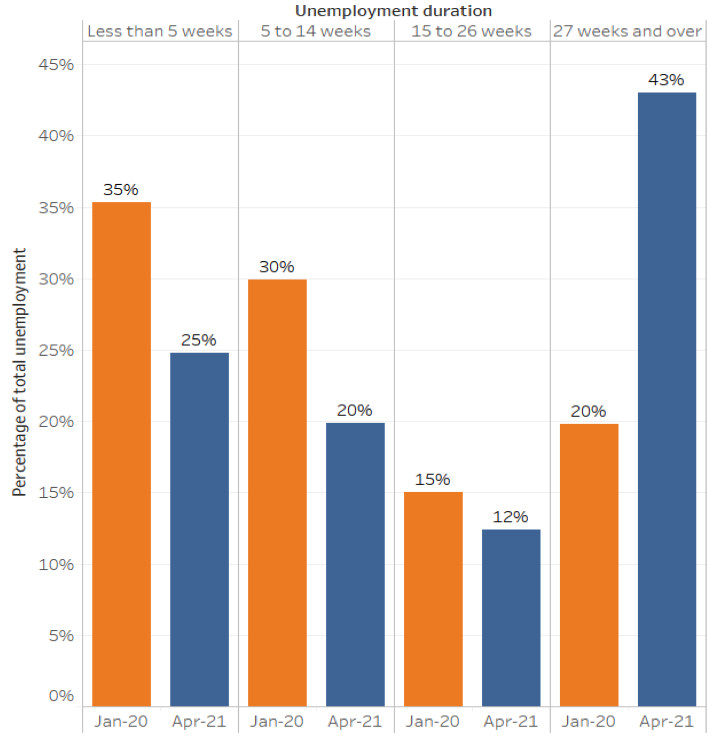The COVID-19 pandemic had severe consequences in King County’s labor market. Successive waves of contaminations led to extended social distancing and gathering restrictions. Hospitality and personal services businesses experienced a sharp decline in revenue and furloughed some staff to remain solvent. The resulting job loss and heightened unemployment insurance claims disproportionally impacted communities of color.
Organizations in workforce development expanded counseling and employment services to assist displaced workers. Effective reemployment strategies could leverage jobs’ skill profiles to identify similar occupations. It would be easier for unemployed workers to transfer to a position with a similar skillset as their previous job.
Using a compatibility index, SJI’s Research and Policy team identified occupational groups. In-demand low automation risk occupations most similar with negatively impacted jobs include entry-level healthcare trades, prevention loss agents, sales agents, and teachers. Availability of short-term training programs and stackable college credentials could be crucial to improve reemployment outcomes.
1. The post-COVID labor market
As the horizon seems to clear up in Washington State from the COVID-19 outbreak, the regional labor market is adjusting to its post-pandemic state. On the one hand, businesses reported troubles with recruiting and increased entry-level positions’ wages to attract applicants. This reflects a mounting labor shortage in hospitality sectors that could be due to the following factors:
- Insufficient childcare availability
- Employees who have been furloughed but found stable employment elsewhere
- Unemployed workers’ fear of getting COVID-19 in the workplace
- For waiters: sizeable unemployment benefits compared to reduced tips revenue
On the other hand, the unemployment rate in King County is still more than double its pre-pandemic level: 5.2% in April 2021 compared to 2.5% in February 2020. As capacity restrictions and social distancing harshly impacted revenue at the height of the pandemic, many small businesses furloughed employees to remain financially solvent, particularly in the hospitality industry. Furloughed workers may be considered eligible for dislocated worker programs and benefit from job training. Still, research indicates that the odds of finding work rapidly decrease with unemployment duration.
The probability of finding a job, estimated at 61% within three months of unemployment, plunges to a mere 20% after an unemployment spell of 13 months or longer (Mueller et al., 2020). Effectively finding employment for pandemic-dislocated workers is a time-sensitive issue as recent data from the Bureau of Labor Statistics points to a stark reversal in unemployment duration trends. In January 2020, 35% of unemployed workers in the country had been out of work for less than five weeks, and only 20% had been out of work for at least 27 weeks. This last category now represents the largest percentage of unemployed workers with 43%.

2. Job skills transferability
Expanding job training programs in the workforce system is beneficial but finding work for the long-term unemployed might get increasingly difficult as employers tend to shun these applicants. However, workforce system organizations could leverage skill transferability patterns to facilitate reemployment strategies. To perform well in their job, workers must rely on a specific set of skills, depending on their role and industry. For example, waiters and waitresses must display strong listening and oral abilities and social perceptiveness. Skills can be broken down into soft and hard skills:
- Hard skills are easily quantified and evaluated and often refer to technical, digital, or language knowledge. Examples include how well a worker can speak Spanish, her expertise at Microsoft Excel, or whether she holds a bachelor’s degree in calculus.
- In contrast, soft skills cannot be measured on a standard rating scale. They refer to the worker’s behavioral aptitudes and interpersonal relationships with her colleagues, customers, suppliers, etc. Specific examples include the worker’s creativity, critical thinking skills, and leadership.
O*NET, the Occupational Information Network database maintained by the U.S. Department of Labor, established comprehensive soft skills profiles for numerous jobs. First, 35 soft skills have been identified and include ten basic skills, 11 technical skills, six social skills, four resource management skills, three socio-technical systems, and problem-solving. Depending on the task, workers may need an expert or basic knowledge of a skill and use it more or less frequently on the job. In addition to soft skills, hard skills are a crucial part of job descriptions and heavily depend on the industry and job title. It is thus difficult, if not impossible, to establish an exhaustive list of hard skills. Still, comparing this information across jobs (soft and hard skills needed, depth of knowledge required, and how often the worker uses them) helps identify similar occupations.
3. Jobs impacted by the pandemic and compatible employment
Unemployment insurance data reveals that jobs in food services and drinking places were the most impacted at the beginning of the pandemic, with 4,679 initial unemployment claims registered in the first week of April 2020. Initial UI claims in this sector decreased to 700 in the week ending April 25th, 2021 due to relaxed gathering restrictions and workers finding jobs in other industries. Still, continued UI claims remain significant for some positions:
- 296 for Customer Services Representatives
- 295 for Production Workers
- 270 for Cashiers
Impacted occupations’ skills profiles can help identify in-demand, low automation risk occupations that rely on a similar skillset. For hospitality and personal services affected by the crisis, similar professions include Loss Prevention Agents, Advertising Sales Agents, Surgical Technologists, or Registered Nurses. For jobs in the entertainment and creative industries, they include Multimedia Artists and Animators, Preschool and Secondary School Teachers, Sales Agents in Financial Services, or Ophthalmic Medical Technicians.
4. In-demand skills and training
While Registered Nurse is a certified occupation in Washington State requiring at least two years of post-secondary education, other jobs can be accessed following short-term training. Surgical Technologists and Ophthalmic Medical Technical usually require a certificate or a post-secondary non-degree award followed by a national certification exam. Similarly, recent initiatives from workforce development partners provide a rapid ramp into healthcare careers: IHAP from SJI, I-BEST Nursing Assistant in community colleges, iCATCH from Housing Hope, and CareerWork$ Medical from Goodwill.
Additionally, many dislocated hospitality and retail workers have extensive experience in customer service, selling techniques, and sales. These skills are sought out in many industries such as Home Centers, Employment Placement Agencies, Electronic Shopping, and Mail-Order Houses. Applicants may enroll in short-term training programs (6-week to 2-quarter certificates) at post-secondary institutions to improve their customer and sales skills and acquire a formal credential recognized by employers.
Besides, irrespective of impacted jobs, many recent entry-level job postings ask for digital and technology skills. Such skills include Amazon Warehouse Services, SQL, Software Development, and programming languages like Java and Python. It is often assumed that these occupations require lengthy training, but workforce development organizations have recently set up short-term programs for low-income applicants who might be interested in tech occupations. For example, North Seattle College’s AWS Cloud Academy Foundations is only two-month-long, while Computing for All offers pre-apprenticeships in IT Support and Software Development.
Still, online learning platforms from for-profit companies (Coursera, edX, Coding Dojo, etc.) and community colleges (ed2go.com) provide a wide array of topics, in-demand tech skills, and course lengths. However, many of these learning solutions are prohibitively expensive. They offer no or limited financial assistance, and students often pay tuition out-of-pocket. Expanding financial aid to online learning platforms could help close the equity and diversity gap in tech occupations.
Want to see more like this? Sign up for the SJI Consulting & Research Newsletter and every other month get connected directly to our projects and what we are learning and reading.
To find COVID-19 information in multiple languages, please visit the King County COVID resource page. To find a vaccination location near you, click on the CDC button below.

Recent Comments